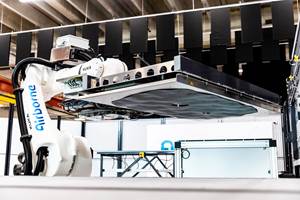Augsburg AI Production Network makes headway with research facility space
AI-based solutions for sustainable, highly modular and material-optimized production, from ultrasonic sensors to recycling CMC, will continue to be pioneered in a new, 7,000-square-meter facility in Augsburg, Germany.

New research facility space. Photo Credit: Regio Augsburg Wirtschaft GmbH. Fotograf Stefan May
The Augsburg AI Production Network’s proposed lease for facility and office space totaling 7,000 square meters on the grounds of the Walter Technology Campus Augsburg (Germany) was recently signed by the University of Augsburg (UNA). The Augsburg AI Production Network, was launched in January 2021 by UNA, the German Aerospace Center (DLR) Center of Lightweight Production Technologies (ZLP) and the Fraunhofer Institute for Foundry, Composites and Processing Technology (IGCV). The measure enables the Network to transfer their pioneering research on smart production (see “Customizing ultrasonic sensors for composites process optimization and control” for examples) from laboratory to industrial scale, a €92 million project funded by the Bavarian state government’s Hightech Agenda pot.
“This is a great start into 2022 for the high-tech region [of] Augsburg,” notes Bavaria’s Minister of Economic Affairs Hubert Aiwanger. “Artificial intelligence [AI] opens up completely new perspectives for our companies and enables new business models. Every euro spent on AI research is an investment in Bavaria’s competitiveness. I am convinced: Far-reaching impulses for our economy will come from the new AI Production Network in Augsburg.”
Bavaria’s Science Minister Bernd Sibler emphasizes this point in cross-institutional research, acknowledging that an additional €3.5 billion is flowing into key technologies such as AI, among others, through the Augsburg region’s Hightech Agenda Bayern and Hightech Agenda Plus alone.
Together, partners under the Augsburg AI Production Network are moving into their next phase of development. “The infrastructure of the research facility still has to be prepared for our projects — in the future, pioneering production technologies [of industrial complexity] will be researched [within the new research facility],” says Prof. Dr. Sabine Doering-Manteuffel, president of UNA. “Artificial intelligence will enable new solutions at crucial points — for example in the area of production and material optimization or in the digitalization and self-organization of manufacturing.”
“We would like to thank everyone who launched and supported this initiative with us — many players have worked together here. We are looking forward to contributing our expertise and skills in the field of holistic lightweight production,” says Prof. Dr.-Ing. Michael Kupke, head of DLR ZLP Augsburg.”
Research projects under the Augsburg AI Production Network will be initiated until 2025, and a technology platform for the successful transfer from basic research to applied research will be established. “In the research network, there are comprehensive competences for the implementation of intelligent, sustainable supply chains, generative production methods and material-adapted design. Material-adaptive production processes and their planning as well as integrated material and component testing are thus made possible. These potentials are now to be used for the specific problems from regional industry in order to jointly develop tailor-made solutions,” explains Prof. Dr.-Ing. Klaus Drechsler, managing director of Fraunhofer IGCV.
The AI production network is complemented by further joint activities with regional partners such as the Swabian Chamber of Industry and Commerce, the Swabian Chamber of Crafts, the Bavarian Metal and Electrical Industry Association, the Bavarian Business Association, Bayern Innovativ and Composites United e.V.. An AI steering group was initiated by the city of Augsburg for this purpose, which coordinates the needs of regional industrial companies.
Related Content
How AI is improving composites operations and factory sustainability
Workforce pain points and various logistical challenges are putting operations resilience and flexibility to the test, but Industry 4.0 advancements could be the key to composites manufacturers’ transformation.
Read MoreBroetje-Automation demonstrates rCF placement via AFP
Through the ScrapSeRO project, the system integrator and machine builder successfully processed recycled composites, in addition to more traditional materials, via its highly flexible Staxx One system.
Read MoreFlyber launches U.K. composites manufacturing site for advanced mobility applications
The startup’s design automation and composite material layup and curing technologies target lightweighting for aerospace, UAVs, eVTOL and high-performance mobility platforms.
Read MoreModular, robotic cells enable high-rate RTM using any material format
Airborne’s automated ply placement systems at Airbus, GKN Aerospace and Teijin Automotive Technologies aim to maximize flexibility and intelligent automation.
Read MoreRead Next
“Structured air” TPS safeguards composite structures
Powered by an 85% air/15% pure polyimide aerogel, Blueshift’s novel material system protects structures during transient thermal events from -200°C to beyond 2400°C for rockets, battery boxes and more.
Read MoreVIDEO: High-volume processing for fiberglass components
Cannon Ergos, a company specializing in high-ton presses and equipment for composites fabrication and plastics processing, displayed automotive and industrial components at CAMX 2024.
Read MoreAll-recycled, needle-punched nonwoven CFRP slashes carbon footprint of Formula 2 seat
Dallara and Tenowo collaborate to produce a race-ready Formula 2 seat using recycled carbon fiber, reducing CO2 emissions by 97.5% compared to virgin materials.
Read More












